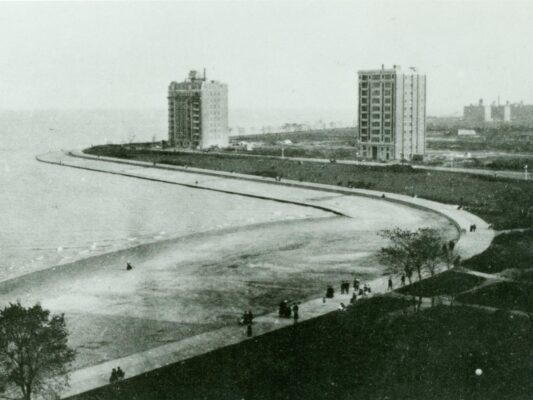
Section 106 of the National Historic Preservation Act requires Federal agencies to take into account the effects of their undertakings on historic properties and afford the Advisory Council on Historic Preservation a reasonable opportunity to comment on such undertakings. Historical properties are defined as “any prehistoric or historic district, site, building, structure or object included in or eligible for inclusion in the National Register of Historic Places (NRHP)”.
Civiltech’s North DuSable Lake Shore Drive (NDLSD) Phase I Study is subject to compliance with Section 106 since the project aims to use Federal-aid Highway Program funds. In September of 2022, the NDLSD project reached an important milestone in receiving concurrence from the State Historic Preservation Office (SHPO) on the Section 106 Historic Properties Identification (HPI) Report.
The NDLSD Section 106 team, led by Civiltech’s Jen Hyman, P.E., included experienced historians Julia Bachrach and Liz Patterson. The team, which included five other researchers, logged thousands of hours of investigation and documentation over several years to complete the HPI report.
An Extensive, Complex, and Unique Undertaking
The purpose of the HPI is to identify historic properties within the project’s Area of Potential Effects (APE). The APE encompasses areas that could be impacted by physical changes resulting from the project, including audible and visual changes. To define these limits for the NDLSD project, several field visits with the NDLSD team and resource agencies were completed. The NDLSD Area of Potential Effects covered over 2,200 acres, including the entirety of Lincoln Park and over 300 buildings in the adjacent communities of Near North, Lincoln Park, Lakeview, Uptown, and Edgewater. Once the APE was defined, the project team was charged with identifying properties within the APE that are currently listed on the NRHP, and determining which properties are recommended as eligible for listing on the NRHP. To support these recommendations, a wealth of public records were researched, including fire insurance maps, archives of historic newspapers, census records, and building permits, to name a few. The project team understood this area contained some of the most important architecture and culture in the City, if not the entire country, and that extensive research was needed to capture this rich history. 
The entire seven-mile NDLSD corridor runs through Lincoln Park, which is already listed in its entirety on the NRHP as a historic district. Julia had authored the NRHP nomination that led to Lincoln Park’s listing as a historic district on the NRHP in 1994. Efforts for the NDLSD HPI involved updating this nomination by reviewing all buildings, objects, artwork, site and landscape features, including the Drive itself, to determine which items contributed to the significance of Lincoln Park. Over 200 items of all sizes, from the Lincoln Park Conservatory to the Putnam Chain, were located, reviewed, mapped, and photographed. More than half of these were determined to be contributing features to the Park, including NDLSD as a linear resource within an eligible historic district.
For each of the five Community Areas, the team first looked at the history of the Drive within each area. For individual properties, they prepared a spreadsheet with every address within the APE and assigned different buildings to different team members. As the Team studied communities and properties to support recommendations of eligibility, they completed surveys to collect the data needed per National Park Service (NPS) guidelines and to the level of detail deemed necessary for the specific project.
The Finished Product
The final report and appendices are over 3,000 pages long and as described above, include a documented history of Lincoln Park, the development of the surrounding communities, and NDLSD itself. The complete report can be found on the NDLSD Phase I Study project website located here: https://northdusablelakeshoredrive.org/section_106_documents.html. The final report identified 15 resources already listed in the NRHP, 10 resources previously determined as eligible for the NRHP and 150 resources recommended as eligible for the NRHP. The report also gives a comprehensive and thorough history of the interesting and noteworthy people, culture, and architecture of this renowned section of the City.
Next Steps in the Section 106 Process
The next phase of the Section 106 process is to assess the effects of any proposed improvements on resources that are either already listed on the NR or have been determined to be eligible for listing. Both designations are afforded the same consideration under the NRHP. This assessment can begin once a preferred alternative has been selected for the project, which is anticipated to occur this year.
